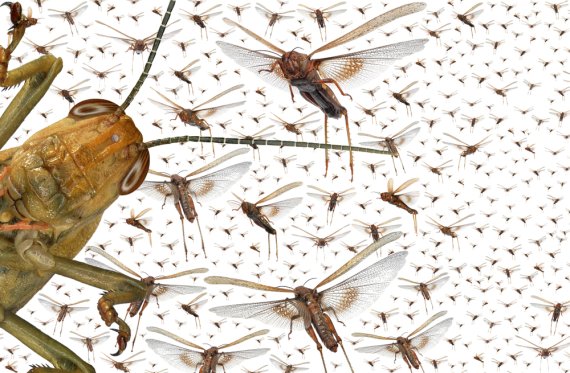How does a swarm such as this originate?
‘Under normal circumstances, desert locusts are solitary creatures. However, favourable conditions such as plenty of rain leading to an increase in vegetation, cause the locusts to multiply at a higher rate. If a period of drought follows, the lush areas diminish, leading to a high concentration of locusts in that area. Another reason for the locusts to band together could be when they encounter a barrier, such as a mountain range or the Red Sea, which is also an area notorious for the origination of locust swarms. Once huddled together, the locusts become gregarious, which means they relinquish their solitary existence and start to swarm. The neurotransmitter serotonin is responsible for this change in behaviour. The locusts attract each other, their bodies shorten, and they change their colour from green to yellow-black. They also change from vegetarians into omnivores. This change takes place gradually, over three generations, approximately nine months in locust cycles. This transformation results from physical contact, and can be simulated in a laboratory by stroking the hind legs with a brush.’
Infestations of this kind can last months to years.
Arnold van Huis of the Laboratory for Entomology
What is the impact of a plague like this?
‘Each day, a locust consumes his body weight in plants, approximately 2 grammes. According to FAO estimates, a ton of locusts, which is just a small portion of the swarm, can consume the equivalent of meals for 2500 people. A swarm can grow up to a thousand square kilometres in size, and travel 100 to 150 kilometres per day. A square kilometre contains about forty million locusts, migrating across the country like an army. Everywhere they land, they lay eggs, some 200 per female, which in turn can cause the next locust plague. Thus, the population can increase tenfold every few months. Plagues such as this can last for months to years. The last big plagues in Africa were recorded from 1986-1987 and 2003-2005. Before 1963, there were five big infestations, one of which lasted as long as 14 years (1949-1963).’
In previous research, we demonstrated that spraying pesticides kills 20 to 30 per cent of the animals
How can a swarm be combatted?
With difficulty. The only method is through pesticides. In previous research, we demonstrated that spraying pesticides kills 20 to 30 per cent of the animals. If a population increases tenfold, it requires killing 90 to 95 per cent of the population to bring it back to a stable level. A few crop dusters won’t do the trick. Furthermore, these countries lack capacity and knowledge because plagues don’t occur frequently. In that sense, it’s a logistical nightmare.
Once the locusts start to swarm, they will not quickly return to their solitary existence. The best scenario is a change in weather conditions, such as a drop in temperatures. The cold of winter in Northwest Africa killed the plague in 2005.
It is of little comfort that locusts are edible. And although they are certainly consumed in these areas, this has no effect in terms of decreasing the plague. A swarm is typically many tens of square kilometres in size, which makes it impossible to catch, let alone consume, them all. Besides, they may contain pesticides. Although environmentally friendly pesticides such as a fungus specimen are available, they fail to cause instant death, which is much needed.’
It is unlikely that climate change causes the swarms
Could the locusts jump to other continents?
‘In 1988 a swarm crossed over from Mauritania to the Caribbean. The flock travelled 5000 kilometres in one week, but they piggybacked on a cyclone. Occasionally, a swarm will engulf an entire ship, or land on the sea, effectively causing an island made up of locusts, that will eventually eat each other.’
Could something like climate change cause a plague like this in the Netherlands?
No. There are only four types of locusts in Africa that can swarm: the desert locust (occurs in 65 countries, from Mauritania to Bangladesh), the red locust (Eastern and Southern Africa), the brown locust (Southern Africa) and the pilgrim locust (mostly in the Niger Delta). These species do not occur in the Netherlands. It is unlikely that climate change causes the swarms. Before 1963, there were five plagues; after that date, only two. If climate change were a factor, I would expect an increase in the number of plagues. However, over the last decade, there has been an increase in the number of cyclones in the Indian Ocean (especially in 2018 and 2019), a phenomenon with which plagues are often associated.’

 Photo: Shutterstock
Photo: Shutterstock